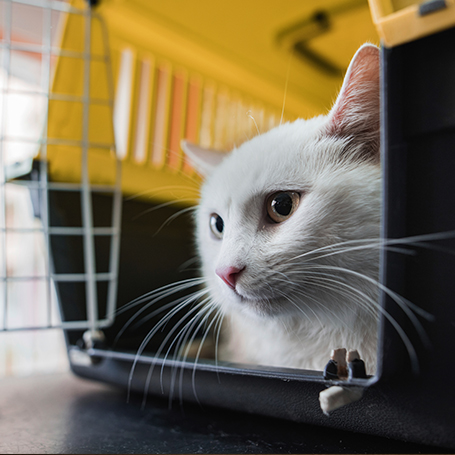Minimally Invasive Surgery Options at Syosset Animal Hospital
Laparoscopic surgeries are less invasive, cutting-edge alternatives to traditional pet surgeries. In a laparoscopic surgery, a camera is inserted into a small incision in the abdomen. With this camera, the veterinary surgeon can see internal organs magnified on a monitor, allowing for more precision. To conduct the actual surgery, small “ports” are created in the abdomen to insert tools, but because of the camera, large incisions are not needed.
Laparoscopic Spays
Laparoscopic spays—the removal of ovaries so your pet cannot have puppies or kittens—offer your pets less pain and shorter postoperative recovery times than traditional spays.
The cameras utilized with laparoscopic spays allow for more precision, so surgeons can cauterize the ligaments that connect the ovaries to the abdominal wall. This greatly reduces trauma and postoperative pain, and, generally, pets heal faster after laparoscopic spays because they are much less invasive than traditional spays.
Laparoscopic-Assisted Gastropexy
Gastropexy is a surgical procedure in which the surgeon tacks the stomach to the body wall to prevent gastric dilatation volvulus (GDV), more commonly known as torsion bloat. GDV occurs when the stomach fills with gas and flips over, and gastropexy prevents the stomach from turning. Laparoscopic-assisted gastropexy procedures are minimally invasive, so pets heal from them quickly.
Laparoscopic Liver Biopsies
A liver biopsy involves taking a small piece of tissue from the liver. Our veterinarians then examine the tissue for abnormalities, which helps diagnose various liver diseases. By conducting a liver biopsy laparoscopically, we not only can view the surface of the liver with the laparoscopic camera, but we also don’t have to make a large incision. Plus, we can pinpoint a specific area of the liver to biopsy, if needed.
Endoscopies
Endoscopies are used to examine the digestive tract, and they can help diagnose diseases of the esophagus, stomach and small intestine. The endoscope can look for abnormalities inside these organs and can take biopsies of tissues if needed. Endoscopies can often also be used to remove foreign bodies pets ingested, eliminating the need for invasive surgery.
Colonoscopies
Colonoscopies are similar to endoscopies, but they examine inside of the rectum and colon. Colonoscopies look for abnormalities and signs of disease inside the rectum and colon and can take biopsies of tissues and/or remove polyps if needed.

